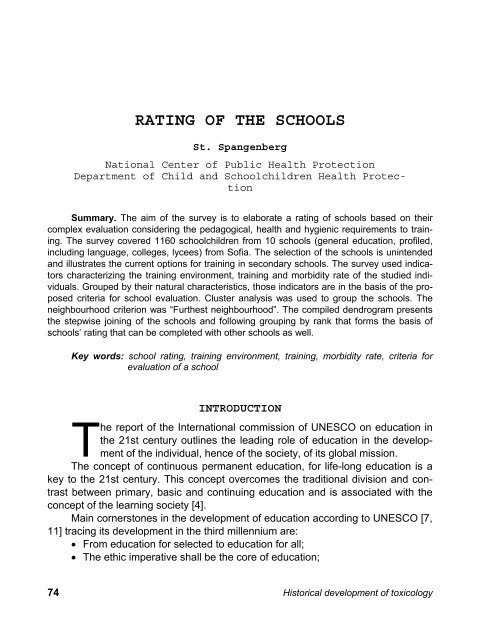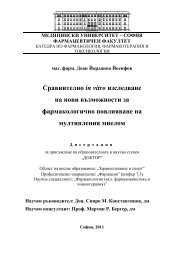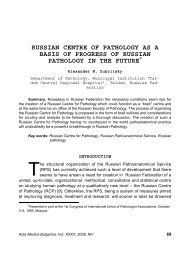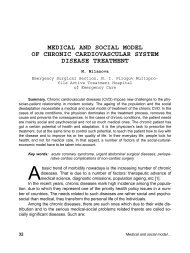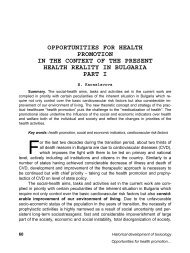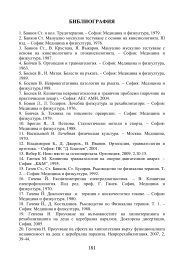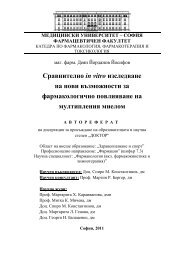RATING OF THE SCHOOLS
RATING OF THE SCHOOLS
RATING OF THE SCHOOLS
You also want an ePaper? Increase the reach of your titles
YUMPU automatically turns print PDFs into web optimized ePapers that Google loves.
74<br />
<strong>RATING</strong> <strong>OF</strong> <strong>THE</strong> <strong>SCHOOLS</strong><br />
St. Spangenberg<br />
National Center of Public Health Protection<br />
Department of Child and Schoolchildren Health Protection<br />
Summary. The aim of the survey is to elaborate a rating of schools based on their<br />
complex evaluation considering the pedagogical, health and hygienic requirements to training.<br />
The survey covered 1160 schoolchildren from 10 schools (general education, profiled,<br />
including language, colleges, lycees) from Sofia. The selection of the schools is unintended<br />
and illustrates the current options for training in secondary schools. The survey used indicators<br />
characterizing the training environment, training and morbidity rate of the studied individuals.<br />
Grouped by their natural characteristics, those indicators are in the basis of the proposed<br />
criteria for school evaluation. Cluster analysis was used to group the schools. The<br />
neighbourhood criterion was “Furthest neighbourhood”. The compiled dendrogram presents<br />
the stepwise joining of the schools and following grouping by rank that forms the basis of<br />
schools’ rating that can be completed with other schools as well.<br />
Key words: school rating, training environment, training, morbidity rate, criteria for<br />
evaluation of a school<br />
INTRODUCTION<br />
T<br />
he report of the International commission of UNESCO on education in<br />
the 21st century outlines the leading role of education in the development<br />
of the individual, hence of the society, of its global mission.<br />
The concept of continuous permanent education, for life-long education is a<br />
key to the 21st century. This concept overcomes the traditional division and contrast<br />
between primary, basic and continuing education and is associated with the<br />
concept of the learning society [4].<br />
Main cornerstones in the development of education according to UNESCO [7,<br />
11] tracing its development in the third millennium are:<br />
• From education for selected to education for all;<br />
• The ethic imperative shall be the core of education;<br />
Historical development of toxicology
• The creative and innovative character shall be the dominant of education;<br />
• Scientifically based knowledge shall be the systematic formation factor of<br />
education contents;<br />
• Variety shall be a main feature of education;<br />
Rating of the schools<br />
• The idea of forestalling education shall be promoted and turned into constructive<br />
feature of the education system.<br />
There is an unanimous standpoint that options for building up a new education<br />
policy are searched for globally. This policy according to A. Tofler is within<br />
identification of schools of the future with parallel curricula, with new attitude to<br />
space and time, with more substantial support of the changes by scientific research<br />
in the field of education policy [17].<br />
The phenomenal functions and characteristics of the school have enabled<br />
and still enable the professionals involved in education issues to create various<br />
models for evaluation of the school, to form variable criteria to establish its relevance<br />
to individual and social requirements [2, 5,10, 16].<br />
There are various, even polar standpoints in the society concerning the<br />
evaluation of Bulgarian school, of its role and achievements, the implementation of<br />
new ideas in education that to a great extent present the attitude and assessment<br />
of the school as an institution.<br />
The elevated requirements to education as a necessary prerequisite for people’s<br />
prosperity in conditions of growing competence in the country and abroad<br />
require a serious evaluation of the achievements in the educational field as well as<br />
of the obstacles to its development.<br />
Modern education supposes harmonization of the training environment and<br />
loading complying with age and individual capacities and preferences of the<br />
schoolchildren for continued education at a higher educational level. The continuity<br />
in education is not an isolated task, it is the possibility for each schoolchild to develop<br />
in the selected field based on achievements during school training. Thus the<br />
choice of an adequate school is particularly relevant currently and supposes<br />
maximal information for the young individuals on possibilities and perspectives offered<br />
by the schools for achieving the correct choice supporting the development<br />
of potential abilities and capacities of the schoolchildren. Moreover, after a 40-year<br />
period of cancelled graduation exams this year they are introduced again in Bulgarian<br />
school and they will be possibly recognized as exams for access to most<br />
universities.<br />
The results of the surveys conducted by us show that there are various secondary<br />
schools on the educational market in our country – general education<br />
schools (GES), profiled, language, specialized, professional schools, colleges, lycees<br />
etc. and in some of them the education is of high level and their graduates<br />
continue their education in prestigious universities in Bulgaria and abroad while in<br />
others the level of education is relatively low, there is no motivation and perspec-<br />
Acta Medica Bulgarica, Vol. XXXV, 2008, №1 75
tive, the school is perceived as an institution necessary only for regulation of an<br />
obligatory education level [1, 12, 14].<br />
And more, in a number of schools that have built up their prestige for decades<br />
and permanently settled on the educational market, having gained the public credit<br />
(National Nature and Mathematics School (NNMS), 1st English Language School<br />
(ELS), 91st German Language School (GLS) etc., the training process is conducted<br />
in an environment not corresponding to the established hygienic requirements<br />
and limits that to a great extent decreases the effectiveness of the training<br />
and has a negative effect on schoolchildren’s health and spirits – something inadmissible<br />
for modern schools.<br />
The results from our survey show that a large number of the schoolchildren<br />
live far from a healthy life; forced stagnant life style, theoretization of the training<br />
etc. are only a part of the issues that have to be resolved in Bulgarian school [12,<br />
13, 15, 16, 17].<br />
The fact that each year some 50 000 schoolchildren leave school and their<br />
number increases progressively not only because of economic stagnation but also<br />
because the parents and the schoolchildren do not see the sense of school training<br />
is alarming [3].<br />
The evaluation of a school is very difficult also because of the fact that besides<br />
schoolchildren’s achievements, of significance are also the training conditions,<br />
possibilities for continued education in universities, possible education destinations,<br />
good sports preparation, acquiring additional skills giving advantages at<br />
applying for universities, good language preparation etc.<br />
In Bulgaria, no comprehensive evaluation of the school based on preset criteria<br />
and indicators as in world practice is performed. The evaluation criteria for current<br />
secondary education cannot be associated only with traditions of the Bulgarian<br />
school, neither with achievements concerning isolated elite cases.<br />
Thus the creation of schools’ rating is particularly important. For this purpose,<br />
though, it is necessary to elaborate objective criteria for the quality of secondary<br />
education on the basis of achievements and shortcomings in pedagogue plan and<br />
based on personal, social and health aspects of the training [15].<br />
76<br />
MATERIAL AND METHODS<br />
A strategy for interaction between “research and school”, for innovational<br />
management and constant organizational development of the schools based on<br />
joint work with individual or groups of schools is incorporated in the basis of the<br />
conceptual model of the survey. This approach enables adequate and permanent<br />
evaluation of the results from the school activity as an institution at available system<br />
for evaluation of school education quality and expert assessment of the school<br />
environment at its active participation, the so called model of parcipative (decentralized)<br />
innovation changes at the school.<br />
Historical development of toxicology
The survey covered 10 Sofia schools as representatives of the variety of training<br />
establishments in the secondary educational grade. Of them with statute of<br />
secondary general education school are 34 GES, 127 GES and 18 GES (except<br />
the classes with studying Japanese, Chinese and Persian language that follow the<br />
curricula for language schools); statute of profiled, including Rating language, of the schools<br />
have 1st ELS, 91 GLS, the American College, NNMS, 31 GES with studying of languages<br />
and management; National Educational Complex with Italian Lycee<br />
(NECIL) and the National Secondary School for Ancient Languages and Cultures<br />
(NSSALC) that are subordinate to the Ministry of Culture. The latter is scientificallymethodologically<br />
integrated with the Sofia University “St. Kliment Ohridski” and has<br />
the statute of National Classic Lycee to Sofia University. With the exception of 34<br />
GES and 127 GES, the enrollment to all profiled, including language, secondary<br />
schools and colleges is through entrance examinations.<br />
The survey covered 1160 schoolchildren from 8th, 9th and 12yh grade of the<br />
studied schools. They were subjected to morbidity assessment based on data from<br />
personal medical records and anamnestic data recorded during medical examinations<br />
during the school year; the morbidity by visits for medical services was followed<br />
as well as the structure of morbidity of the studied schoolchildren, and analyzed<br />
by statistical software SPSS 10.0 and non-parametric analysis – χ2 method<br />
for comparison of table rates, i.e. category features and Kramer’s ratio – v2 for assessment<br />
of relationships and dependences (at p
• Characteristic evaluations – minimal measured values of environmental indicators,<br />
health state indicators;<br />
• Quality characteristics with quantitative dimensions – number of sports facilities,<br />
number of computer rooms;<br />
• Ranking evaluations – indicators of the school as a whole, e.g. documentation,<br />
equipment etc.<br />
• General expert assessments.<br />
• The ranking evaluations of the various indicators are compatible by direction<br />
and scale.<br />
• Those indicators have hierarchic structure, i.e. they are associated with objects<br />
that are a structure of grouping elements:<br />
• School – for the school as a whole, e.g. documentation<br />
• Grade – for school and education grade (preparatory/graduating), mainly<br />
morbidity indicators;<br />
• Class – for the class, e.g. school microclimate indicators – temperature, illumination;<br />
• Individual – individual indicators – heart activity, etc.<br />
The survey used the following statistical methods:<br />
At primary processing we used variation analysis for indicators with numerical<br />
values, and for category indicators – alternative analysis.<br />
For detection of relationships and interactions between various groups of indicators<br />
(health, hygienic, pedagogical) we used correlation, dispersion and χ 2 test<br />
for associations.<br />
The assessment of school hygienic parameters and their compliance with set<br />
limits was assessed by dispersion or respectively non-parametric analysis.<br />
The morbidity data by nosological units were used as indicators for morbidity<br />
assessment.<br />
78<br />
RESULTS<br />
The rating of the schools from the secondary education system cannot be<br />
made without objective criteria. The studied indicators grouped by their natural<br />
characteristics are in the basis of the proposed criteria for evaluation of the school,<br />
namely: training documentation, training quality, learning quality (results), teachers’<br />
staff, quality of the training environment, level (quality) of school services, schoolchildren’s<br />
morbidity rate [7].<br />
The results from the cluster formation by variables defining the school (pedagogical),<br />
training environment (hygienic) and morbidity are shown on Fig. 2 and<br />
Fig. 3. As neighborhood criterion was used “Furthest neighbourhood”, i.e. that of<br />
the most distant neighbour. It is interesting that the ordering of the schools<br />
changes depending on the leading factor, thus outlining that the good educational<br />
Historical development of toxicology
level does not always correspond to low morbidity rate and hygienic training environment.<br />
The results of the survey show that the marks of the schoolchildren from profiled<br />
secondary schools, including language schools, are higher than those in GES<br />
evidenced by higher average marks by basic disciplines at enrollment and at<br />
graduation (Fig. 1). This is the possible reason for the rate of schoolchildren successfully<br />
accepted in higher institutes. In some classes it reaches Rating even of 100%. the schools<br />
average marks above<br />
excellent in %<br />
120<br />
105<br />
90<br />
75<br />
60<br />
45<br />
30<br />
89<br />
78<br />
77 76<br />
Fig. 1. School marks of schoolchildren from 12 grade (average marks above excellent 5, 50)<br />
ELS – English Languege School; GES – General Education School;<br />
NECIL – National Educational Complex with Italian Lycee;<br />
NMPG – National Nature-Mathematics Secondary School;<br />
NSSALC – ational Secondary School for Ancient Languages and Cultures;<br />
GLS – German Language School<br />
Fig. 2 and 3<br />
Acta Medica Bulgarica, Vol. XXXV, 2008, №1 79<br />
70<br />
62<br />
50 47<br />
IELS NMPG NSSALC 91GLS NECIL 18GES 31GES 34GES<br />
schools
The ranging of the schools with different statutes and education type shows<br />
that the profiled secondary schools with national statute (NNMS, NECIL, NSSALC)<br />
are leading among the secondary schools. The rating of those schools is high as,<br />
besides high educational achievements, the training is conducted in very good<br />
conditions of the training environment. The fact that these schools have a developed<br />
system enabling the best students to be accepted in universities without entrance<br />
examination is also important. The provision of this option additionally motivates<br />
those schoolchildren and significantly improves the effectiveness of the training.<br />
In spite of the limited entry, those who wish to study at these schools grow<br />
constantly.<br />
Second ranked are the language schools that by pedagogical characteristics<br />
even override national secondary schools but in some of them, and particularly at<br />
the language classes of GES, there is a substantial discrepancy with the regulatory<br />
requirements to the studied indicators of the training environment and training itself.<br />
It is not just a mere chance that the total morbidity rate is higher for schoolchildren<br />
from those schools.<br />
The results show that GES have their place in our education system and by<br />
some indicators (training loading, curriculum, horarium) they even surpass the language<br />
schools. Nevertheless, the rating of those schools is low as the marks of<br />
schoolchildren from the majority of them are comparatively lower as well as their<br />
possibilities for higher education and competence compared to schoolchildren from<br />
profiled and language schools.<br />
The survey results show also that the training loading at profiled, including<br />
language, schools is significantly greater than that at GES (almost twice greater<br />
lessons for the selected education profile). Thus the schoolchildren’s health status<br />
is of particular importance in selection of a school. The schoolchild nowadays is<br />
exposed to high information and regime overloading due to constantly increasing<br />
requirements to education and non-substantiated reforms, in conditions of nonhygienic<br />
training environment, using obsolete teaching forms and methods (unavailable<br />
audio-visual equipment, working computers etc.), in combination with<br />
unhealthy nutrition and hypodynamia affecting the psycho-physical development<br />
and morbidity rate (increased total morbidity rate, neurotic complaints, visual impairments,<br />
spinal column deformities, increased traumatism etc.). The constantly<br />
increasing intensity and requirements to training affect the labor and health of the<br />
schoolchildren and do not contribute to promoting the effectiveness of school training,<br />
if not combined with permanent optimization of the process and environment.<br />
The survey reveals that the level of preparation and criteria for evaluation of<br />
schoolchildren’s knowledge in the various types and profiles of schools are different.<br />
Those differences are determined by the schoolchildren’s selection at accession<br />
to the school, tutors’ selection, motivation for further realization and last but<br />
not least by the facilities and technical equipment.<br />
80<br />
Historical development of toxicology
The classification of schools with various statute and training type can be<br />
completed with other schools after evaluating the factors characterizing the training<br />
and training environment, based on their compliance with health-hygienic requirements<br />
and limits that would enable the revision of the statute of those schools<br />
Rating of the schools<br />
where severe discrepancy between the declared education goals and factors characterizing<br />
the training and the environment are found. Those discrepancies affect<br />
adversely the schoolchildren’s morbidity rate and are inadmissible for the modern<br />
school.<br />
The grouping of the schools is based on deviations from hygienic requirements<br />
and limits of the studied indicators that to the greatest extent characterize<br />
the quality of the training, environment and services at the school. The confirmed<br />
relationship of those indicators with schoolchildren’s morbidity rate requires their<br />
permanent evaluation for compliance with requirements and limits with a view to<br />
optimization of training environment quality and promoting the competence of the<br />
schools on the education market in Bulgaria. Of importance is also the availability<br />
of a long-term concept for development of secondary education which basic provisions<br />
should be the cornerstone at school evaluation.<br />
CONCLUSIONS<br />
The results from the survey show that the leading places of the ranking are<br />
occupied by profiled (national and language schools). The training there to a great<br />
degree complies with current European requirements in the field of secondary education.<br />
Some of them have achieved a very satisfactory level of training and their<br />
graduates are further educated successfully at very prestigious European and USA<br />
universities.<br />
Schools should not be rated on the basis of evaluation of individual components<br />
as the school is a multicomponent system and the global conclusions for it<br />
are inevitably based on the assessment of the individual components. This, however,<br />
does not mean that the global evaluation of the school is a simple mechanical<br />
sum of the evaluations of the individual components, as well as that each school<br />
should have its own evaluation system. Of importance is also the availability of a<br />
long-term concept for development of secondary education which basic provisions<br />
should be the cornerstone at school evaluation.<br />
The expected changes in secondary education will enable promoted access<br />
of all to quality education affirming regulatory mechanisms for objective evaluation<br />
of the labor, knowledge and competence of all players in the Bulgarian education<br />
space.<br />
Acta Medica Bulgarica, Vol. XXXV, 2008, №1 81
82<br />
REFERENCES<br />
1. A d u l t learning in a world at risk: emerging policies and strategies. Hamburg, UNESCO,<br />
Institute for Education, 1997, 32.<br />
2. B a l k a n s k i, P. [Jubilee Scientific Session “65 years institutionalized research in the<br />
field of education”] Sofia, Collection of materials, 2001, 53-68. (in Bulgarian).<br />
3. M i n i s t r y of Education and Science. National Education Center. [Education for all. National<br />
evaluation – 2000] Sofia, 1999, 135 (in Bulgarian).<br />
4. P e t r o v, P. et M. Atanasova. [Training technologies and learning strategies] Sofia, 2001<br />
(in Bulgarian).<br />
5. S a v o v a, J. [What we know and what we do not know about American education] –<br />
Educ. Manage., 1992, 7-8. (in Bulgarian).<br />
6. S p a n g e n b e r g, S. Education and health – priority of school medicine. – Arch.Balkan<br />
Med. Union, 40, 2005, № 3, 156-161. (in English).<br />
7. S p a n g e n b e r g, S. et al. [Health problems at school.] – Scripta Per., 8, 2005, № 3, 3-<br />
13. (in Bulgarian).<br />
8. S p a n g e n b e r g, S. et al. [Health-hygiene assessment of training in some language<br />
schools in Sofia.] – Hig. i zdraveop., 42, 1999, № 2, 34-38. (in Bulgarian).<br />
9. S p a n g e n b e r g, S. et B. Boeva. [Influence of the factors of the training environment<br />
on students’ health state.] – Gig. i sanit., 2003, № 5, 50-52. (in Russian).<br />
10. S p a n g e n b e r g, S. et R. Ruskova. [Methods for studying the mental capacity of students<br />
from some language schools in Sofia.] – Probl. Hig., 21, 1996, 148-151. (in Bulgarian).<br />
11. S p a n g e n b e r g, S. [Health requirements to training at the modern school.] – Strategies<br />
Educ. Sci. Policy, 2004, № 4, 84-94. (in Bulgarian).<br />
12. S p a n g e n b e r g, S. [Health requirements to training.] – Model Curr. School, 2006, 273.<br />
(in Bulgarian).<br />
13. S p a n g e n b e r g, S. [Hygienic assessment of lessons and marks of schoolchildren<br />
from some profiled schools.] – Antropoekologia, 2000, № 4, 16-23. (in Bulgarian).<br />
14. S t a t i s t i c a l Yearbook. Paris, UNESCO, 1996, 788.<br />
15. T o f l e r, A. [Shock from the future.] Sofia, Nauka i izkustvo, 1973. (in Bulgarian).<br />
16. T s o l o v a, G. [Healthy children in healthy families – children’s component of CINDI programme.]<br />
– Soc. Med., 2007, № 2, 13-14. (in Bulgarian).<br />
17. T s o l o v a, G. Behavioral factors for health risk among schoolchildren aged 14-18 years.<br />
– Arch. Balkan Med. Union, 3, 2007, 144-148.<br />
Address for correspondence:<br />
Assoc. Prof. Stefanka Spangenberg, MD, PhD<br />
National Center of Public Health Protection<br />
Department of Child and Schoolchildren Health Protection<br />
15 ”Acad. I. Gechov” Blvd.<br />
1431 Sofia<br />
Bulgaria<br />
(+3592) 8056374<br />
Historical development of toxicology


